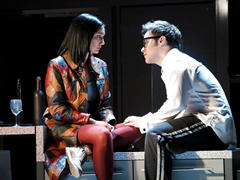| Opera Reviews | 19 April 2024 |
The young ensemble brings La bohème to lifeby Moore Parker |
|
| Puccini: La bohème Wiener Kammeroper 17 February 2013 |
|
|
This talented young cast requires no license, particularly considering the challenge of this condensed version of Puccini's masterpiece in which there is neither an interval nor the ensemble scenes for the soloists in which to catch their breath. Director Lotte de Beer, and her designer team who go under the name of Clement & Sanou chose an essentially triangular-shaped set on two levels, which encompasses the area normally taken by the first three rows of stalls' seats. Thus the orchestra pit is framed on all sides, with the protagonists gaining flexibility in stage area to act out their drama. A modern penthouse setting, slanted shelves lined with garments, a designer-block kitchen all hint at young artists deprived of values other than those of material significance. Some moments of action defy logic, but are inoffensive when compared to the cast's conviction and sincerity, which transport the audience through the intense evening. The basic set remains throughout, with props and minor changes between scenes accompanied by atmospheric compositions combining sound effects with themes from Puccini's score, composed by Sinem Altan. For the finale, gauze screens quickly create a quarantined area for Mimi's demise, isolated and reduced to communication via telephone (though Rodolfo does in fact go to her bedside for their farewell duet). The cast is well-balanced, and the characters well defined and rehearsed. This 21st century troop of nouveau riche students is credible and appealing, with all the leads boasting solid vocal material and techniques, as well as oodles of commitment and verve. While the musical style was generally there in abundance, the cast - to greater or lesser degrees - could well benefit from a good Italian coach. The Mimi, Cigdem Soyarslan is perhaps the most experienced of the current quartet with a number of major roles in various European houses to her credit. For much of the evening she made good use of her rich-timbred soprano, achieving an appealing melange of the nonchalant young city girl and the tragic figure who is ultimately forced to capitulate to her fate. The voice is ample (and not just for this house), so there is really no justification in yielding to the temptation of adding destructive pressure at the top of the range. (Mimi and Rodolfo opt for the unison version to close "O soave fanciulla" - which can be precarious even when cushioned behind the sets of a large theatre, and which in this setting was quite ill advised). Rodolfo, Andrew Owens, can justly revel more in his winning presence and fine lyric tenor. He began a shade tenuously (and with an irritating habit of preparing his lips and jaw before emitting a tone), but after mastering his Act 1 aria with aplomb, appeared to gain in confidence - building his interpretation in the Act 3 trio/quartet, and culminating in a truly moving finale with his Mimi. On this evening Musetta was shared between two artists. Indisposed Anna Maria Sarra (of the original cast) acted the role, which was actually sung from the side of the stage by Anna Gorbachova. The solution worked naturally, with Sarra just hinting at her text and avoiding any temptation to overcompensate for the irregular circumstances. This Musetta came across as a feisty punker with a warm heart and tender gesture - a true foil for Marcello and a touch of spice to augment the other protagonists. Miss Gorbachyova is no newcomer - either to Vienna or to Musetta, which she has performed at the Hungarian State opera. She gave an excellent reading, with her warm lyric soprano easily filling the house, and winning grateful acclaim from her audience and colleagues. Marcello, Ben Connor - building on his success in La cambiale di matrimonio - again displayed a natural aptitude for the stage to compliment his burnished, appealing baritone. An obvious asset to the Kammeroper ensemble. Igor Bakan (possibly more baritone than bass-baritone) brought an nicely-unsentimental, easygoing touch to Colline, and Oleg Loza's dapper Schaunard had just the right swagger. A nice trio of cameos too (Benoit, Alcindoro, and Mimi's Doctor) by Martin Thoma. Claire Levacher, guaranteed unyielding support from the Wiener Kammerorchester in the pit, and which just occasionally could have benefited from a slightly lighter touch. It was pleasing to see an appreciative audience and well-filled house so far into the production series. |
|
| Text ©
Moore Parker Photo © Armin Bardel |
|

 Attempting
standard repertoire automatically brings with it certain risks for a
young ensemble in an intimate venue, with comparisons - even if unwitting
- to favourite interpreters and productions a foregone conclusion.
Attempting
standard repertoire automatically brings with it certain risks for a
young ensemble in an intimate venue, with comparisons - even if unwitting
- to favourite interpreters and productions a foregone conclusion. 





